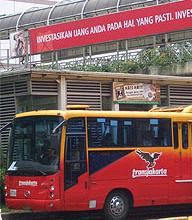What is it?
A 12.9-km bus rapid transit corridor providing extensive bus services to 39 million people through the city of Jakarta, Indonesia.
How does it work?
Inspired by the success of the BRT system in Bogotá and Curitiba, in South America – the Jakarta system is managed and run by a publicly managed company, TransJakarta BP. Its features include:
* 12.9 km fully physically segregated median busway corridor from Blok M.South Jakarta to Kota, West Jakarta, with a route structure of one dedicated bus lane;
* Two additional lines began operation on January 15, 2006 and four more on January 27, 2007. The two additional lines added 84 buses that can transport a maximum of 85 people each per trip – effectively tripling the size of the BRT;
* Currently there are 91 diesel buses and 174 CNG (Compressed Natural Gas) buses for a total of 265 buses. All are Euro II compliant;
* Bus stations provide elevated platforms to ensure quick boarding and alighting. In most cases the stations are connected to the sidewalk by a pedestrian bridge and ramps for easy access;
* Service headway is 2 to 3 minutes during the peak period and 3 to 4 minutes during off-peak periods. Service hours run from 5:00 a.m. until 10:00 p.m;
* Stations are announced through a simultaneous text message sign and audible announcement activated by driver;
* The system is officially integrated with two other feeder services, ticketing mechanisms are still not completely compatible;
* The number of passengers increased from 16 million in 2004 to 39 million in 2006. This can be attributed to:
o More city coverage due to new lines
o Time efficiency and reliability
o Comfort
o Safety
Costs
* There is a flat fare of 3,500 Rp (38 cents) with discounted fare of 2000 (22 cents) from 5am to 7am. Discounted fares are based on passenger demographics.
* The government subsidizes 1700Rp (19 cents) per fare. The amount of government subsidies have gone up due to additional BRT lines and increased number of passengers. The amount of subsidies by year are listed below:
o $5 M USD in 2004
o $7.2 M USD in 2005
o $20 M USD in 2006
o $25 M USD in 2007
Investment
Jakarta spent a total of $26.4 million on the system, with about 40% of costs spent on buses. It has done relatively well to cover its operational expenses, including:
* 2004 (1 line) – 89% coverage of operational expenses
* 2005 (1 line) – 96%
* 2006 (3 lines) – 70% (due to line expansion)
C02 reductions
* 120,000 ton CO2 annually, based on calculations for the seven corridors.
* It's predicted that the 7 corridors will be able to shift 5% of private car passengers to use BRT for an average trip of 20 km per person per day. With this prediction and the emission factors for CO2 of cars and BRT, the conservative calculated CO2 emission reduced in the year 2006 is around 120,000 tons of CO2;
* The City is conducting ongoing surveys to give a better picture on the CO2 reduction potential for the existing corridors as well as for the new one(s).
Next steps
The City plans to:
* Expand to 15 lines by 2010 (10 lines by 2008)
* Make an integrated ticket that will function with other modes and bus feeder services;
* Convert 91 diesel buses to CNG buses by end of 2007;
* Purchase 30 articulated buses, that can carry 160 passengers, by end of this year for most congested sites;
* Consideration has been given to a fare increase from 4500 to 5000Rp (50 to 55 cents).
Application
Research into BRT systems by the Institute for Global Environmental Strategies:
* The infrastructure costs of BRT systems are far less than rail-based systems.
* Existing BRT systems were constructed with costs in the range of US$1-15 million/km, depending on the capacity requirements and complexity of the project, while elevated rail systems and underground systems can cost from US$50 million to over US$200 million /km.
* The number of cities looking into BRT is rapidly increasing, with Asian cities using similar systems to South America’s Curitiba and Bogotá.
* In China, a BRT longer than that in Beijing was officially opened in Hangzou in April 2006 (CAI-Asia 2006b). According to a Website by CAI-Asia (2006a), BRTs are now planned or under construction in 18 cities and under consideration in 5 cities in Asia.
* The potential of BRT to reduce GHG started to be recognised by the global community for climate change policy: a baseline and monitoring methodologies of BRT in Bogotá for the Clean Development Mechanism (CDM) was approved in late July 2006. The approved methodology can be applied to all mass transport systems based on BRT and widened the potential for BRT projects to raise funds from the sale of the environmental service of emission reductions.
* BRTs may not succeed if police enforcement is not strict. Vuchic (2005) cited examples of Philadelphia and Mexico.
* Experiences from the U.S. cities such as Shirley Busway in Washington and El Monte Busway in Los Angels show that pressures by automobile interests are threat to the existence of BRT.
* Relationship of BRT to other modes is a crucial factor for the success of BRT: BRT cannot bring success as a stand-alone policy; effectiveness depends on the presence of complementary transport options, such as promotion of non-motorised transport, and integrated feeder services.



